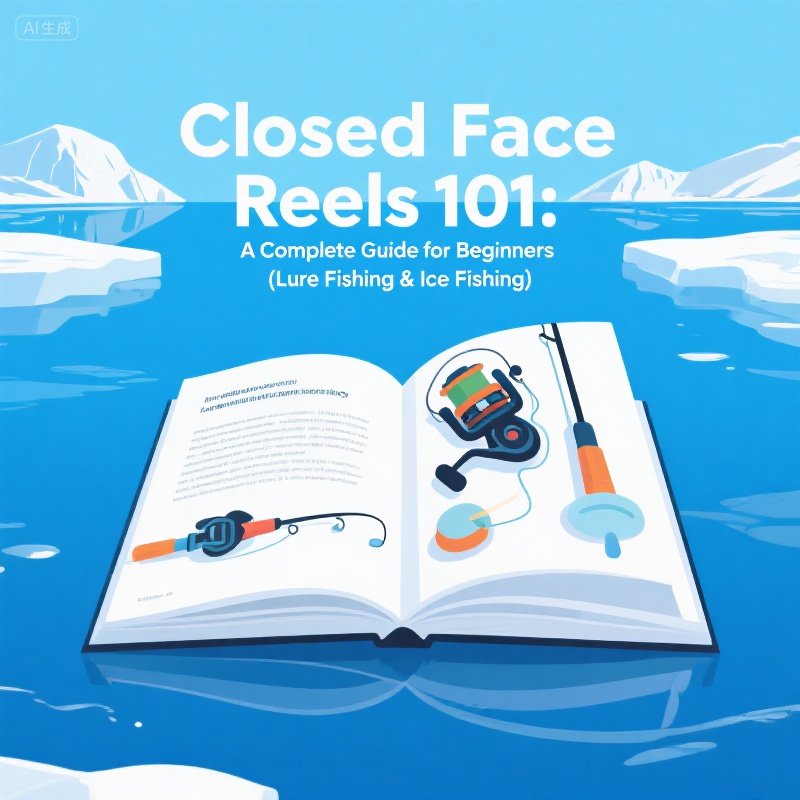Closed Face Reels 101: A Complete Guide for Beginners (Lure Fishing & Ice Fishing)
Welcome to the world of closed face reels—a game-changer for beginner anglers looking to master lure fishing and ice fishing! If you’re tired of tangled lines, inconsistent casting, or feeling overwhelmed by complex reel mechanics, closed face fishing reels are here to simplify your fishing journey. In this guide, we’ll cover everything you need to know about these user-friendly tools, from their core features to choosing the best closed face fishing reel for your needs.
What Are Closed Face Reels?
A closed face reel is a type of fishing reel designed with a protective cover that encloses the spool and line, shielding it from water, debris, and tangles. Unlike open-faced reels, which expose the spool, the closed design makes them incredibly low-maintenance and easy to use—perfect for beginners! They’re typically paired with spinning rods and excel in calm to moderate water conditions, making them ideal for lure fishing (targeting species like bass, panfish, or trout) and ice fishing (where precision and reliability are non-negotiable).
Key Features of Closed Face Fishing Reels
- Tangle-Free Operation: The closed cover prevents line from snagging on fingers or the environment.
- User-Friendly Design: Simple drag adjustment and thumb bar casting make them accessible for all skill levels.
- Durability: Water-resistant construction protects internal components from rust and wear.
- Compact Size: Lightweight and easy to handle, even in cold conditions (a must for ice fishing!).
When to Use Closed Face Reels**: Lure Fishing vs. Ice Fishing**
1. Lure Fishing with Closed Face Reels
Whether you’re casting small jigs for panfish or using crankbaits for bass, closed face reels shine in freshwater scenarios. Their smooth drag system and consistent line lay reduce frustration during long casts or when targeting finicky fish. Plus, the enclosed design means you spend less time untangling line and more time catching fish!
2. Ice Fishing with Closed Face Reels
Ice fishing demands reliability in harsh conditions—thin ice, freezing temperatures, and limited mobility. Closed face reels thrive here: their compact build fits comfortably in gloved hands, while the water-resistant casing prevents ice chunks or snow from jamming the spool. Look for models with quick-set drags to handle sudden strikes from walleye, perch, or panfish through the ice.
Choosing the Best Closed Face Fishing Reel**: Key Factors for Beginners**
With so many options on the market, here’s how to find the best closed face spinning reel for your needs:
1. Size & Line Capacity
- Ultra-Light (1-3 lbs max drag): Ideal for panfish, trout, or ice fishing (line size: 2-4 lb test).
- Light-Medium (4-6 lbs max drag): Perfect for bass, perch, or general freshwater lure fishing (line size: 4-6 lb test).
2. Drag System
Opt for a reel with a smooth, adjustable drag (spin-style or lever drag). A reliable drag prevents line breakage when hooked to a big fish, especially crucial in ice fishing where fish can strike aggressively.
3. Spool Material & Bearings
- Aluminum or Graphite Spools: Lightweight and corrosion-resistant (graphite is better for cold conditions like ice fishing).
- Bearings: More bearings (e.g., 5+ BB) mean smoother operation, but prioritize quality over quantity for durability.
4. Anti-Reverse System
Ensure your reel has a locked anti-reverse feature to prevent the handle from spinning backward—vital for setting hooks quickly in both lure fishing and ice fishing.
Top Picks for Beginners:
- Piscifun Salon: Budget-friendly, lightweight, and perfect for panfish/ice fishing.
- Shakespeare Ugly Stik GX2: Durable graphite construction, smooth drag, ideal for bass and trout.
- Daiwa Revros LT: High-quality bearings and compact design, great for all-around lure fishing.
How to Use a Closed Face Reel**: Step-by-Step Tips**
- Set Up Your Rig: Thread the line through the guides, attach a swivel and leader (for ice fishing, use a shorter leader to prevent ice buildup).
- Adjust Drag: Turn the drag knob clockwise to tighten (for fighting fish) or counterclockwise to loosen (for casting).
- Casting: Depress the thumb bar, hold the line with your forefinger, and swing the rod forward—release the bar smoothly as the rod tip points toward the target.
- Reeling In: Keep the rod tip at a 45° angle, maintain steady pressure, and use the drag if a fish makes a run.
- Maintenance: After ice fishing, wipe down the reel with a dry cloth to remove moisture; for regular care, clean with mild soap and lubricate moving parts annually.
Common Mistakes to Avoid
- Overfilling the Spool: Leave ¼ inch of space between the line and the spool edge to prevent line backlash.
- Ignoring Drag Settings: Start with a light drag for casting, then adjust based on fish size (too much drag can snap the line!).
- Neglecting Maintenance: Even water-resistant reels need occasional cleaning—dried salt or dirt can jam the mechanism.
Conclusion: Why Closed Face Reels Are a Beginner’s Best Friend
Whether you’re casting lures in a tranquil lake or drilling holes through the ice, closed face reels offer simplicity, reliability, and fun. By choosing the right model for your target species and mastering basic techniques, you’ll be hooking fish in no time. Remember—consistency and practice are key, and with a best closed face spinning reel by your side, every trip feels like a successful adventure!
Ready to get started? Share your favorite closed face reel experiences or ask questions in the comments below!











Leave a comment